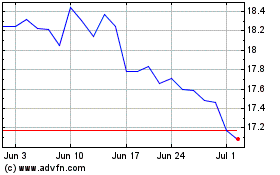California Claims PG&E Falsified Gas Safety Records - Update
December 14 2018 - 8:47PM
Dow Jones News
By Katherine Blunt and Russell Gold
PG&E Corp. falsified natural gas pipeline-safety records
over five years, California regulators said Friday, dealing another
blow to the state's largest utility as it struggles with mounting
lawsuits stemming from devastating wildfires.
The California Public Utilities Commission said an investigation
by its safety division found that PG&E lacked sufficient
staffing to locate and mark natural-gas pipelines as required by
law, and pressured employees to complete the work.
As a result, the agency alleged, PG&E staff falsified
thousands of those records between 2012 and 2017. The claims
included marking the precise locations of its natural gas pipelines
in a timely manner so that the information could be used by
construction companies and others for safety purposes.
A report by the commission contends it was "common knowledge"
among PG&E supervisors that their staff falsified records to
avoid "late tickets" for failing to complete the work on time. The
agency alleges the company undercounted tens of thousands of late
tickets between 2012 and 2017.
The commission directed PG&E to take "immediate corrective
measures" and opened a proceeding to consider penalties against the
company.
PG&E said Friday that it is taking actions in response to
the state's findings, including enhanced auditing, hiring more
employees and improving their training doing the pipeline safety
work.
"We're committed to accurate and thorough reporting and
record-keeping, and we didn't live up to that commitment in this
case," the utility said in a statement. "Once that became apparent,
we took and continue to take additional actions to meet the
regulatory standards."
The commission said it was tipped to the alleged violations by
the federal Pipeline and Hazardous Materials Safety
Administration
"Utility falsification of safety related records is a serious
violation of law and diminishes our trust in the utility's reports
on their progress," CPUC President Michael Picker said in a
statement. "These findings are another example of why we are
investigating PG&E's safety culture."
The CPUC last month expanded a continuing probe of PG&E's
safety practices and said it would explore the way the company is
structured and managed.
The commission began the investigation of the company's safety
culture three years ago, after a devastating natural-gas pipeline
explosion in 2010 killed eight people and caused widespread damage
in San Bruno, Calif. The company was fined $1.6 billion by state
regulators in connection with that incident. It also was fined $3
million by a federal judge and is on federal probation as a
result.
PG&E shares have fallen sharply in recent weeks after the
company disclosed that some of its equipment malfunctioned in the
area of last month's Camp Fire, minutes before the fire was
reported. The Camp Fire killed at least 86 people and destroyed
about 14,000 homes, making it the state's deadliest fire.
The utility released new information this week indicating that
one of its power lines near where the Camp Fire started Nov. 8 came
apart immediately beforehand and fell from the metal tower that
held it aloft. Investigators, who are still trying to determine the
cause of the fire, removed some utility equipment from the power
line and from another line with broken power poles for closer
analysis.
PG&E asked state regulators on Thursday to approve a plan to
sharply increase revenue for a three-year period, with a rate
increase on customers of 12%, or $1.1 billion, in 2020 that would
rise to 24%, or more than $2 billion a year, by 2022.
The company said the request reflected anticipated additional
spending on wildfire mitigation and insurance costs, but didn't
include the largest potential expenses it faces: liability from
lawsuits alleging it is to blame for wildfires in recent years.
Experts have estimated those liability costs could run into the
tens of billions of dollars.
While state fire investigators haven't determined whether
PG&E equipment was to blame for the Camp Fire, or the worst
fire of 2017, known as the Tubbs fire, they have has found PG&E
responsible for 17 major fires in 2017 that destroyed 3,256
structures and killed 22 people. Eleven of those cases have been
referred to county district attorneys for possible criminal charges
against PG&E.
Michael Wara, director of the climate and energy policy program
at Stanford University's Woods Institute, said the allegations that
PG&E faked pipeline safety records will put the company in
legal jeopardy and sour an already disintegrating relationship with
California regulators.
"I think the issue is can the existing management remain in
place? The board and the management?" Mr. Wara said. "This is the
kind of thing that could lead to a big accident," he added.
Write to Katherine Blunt at Katherine.Blunt@wsj.com and Russell
Gold at russell.gold@wsj.com
(END) Dow Jones Newswires
December 14, 2018 20:32 ET (01:32 GMT)
Copyright (c) 2018 Dow Jones & Company, Inc.
PG&E (NYSE:PCG)
Historical Stock Chart
From Mar 2024 to Apr 2024

PG&E (NYSE:PCG)
Historical Stock Chart
From Apr 2023 to Apr 2024
